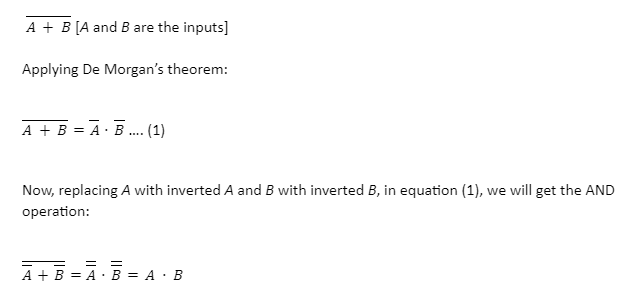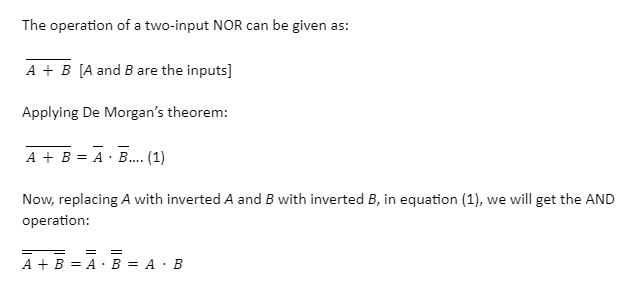A logic gate is an electronic circuit with two or more inputs but one output that occurs only for a certain combination of inputs. There are three basic logic gates: OR, AND, and NOT, which are considered as the basic building blocks of any logic circuit. By combining these gates, we can develop two combination gates– NAND and NOR. They are called the universal building blocks of all digital circuits. This is because by using only NAND or NOR gates repeatedly, one can get the logic function of all the gates.
A NOR gate functions as NOT operation of OR gate. The gate provides a high output signal only when there are low signals on the inputs. A NOR gate is constructed using a NOT and an OR gate.
Building a NOR using a NOT and an OR gate
A NOR gate’s operation can be realized using a NOT and an OR Gate. Its first operation is OR, the result of which is then inverted using a NOT operation. The following circuit symbol shows a two-input NOR:
Here, A and B signify the two inputs of the NOR arrangement. The output of NOR is 1, only when all inputs are 0. For all other combinations of inputs, the output is 0.
Input A | Input B | A+B | Output: |
0 | 0 | 0 | 1 |
0 | 1 | 1 | 0 |
1 | 0 | 1 | 0 |
1 | 1 | 1 | 0 |
The operation can be defined as: If both inputs are NOT true (or FALSE), then output is TRUE.
According to De Morgan’s theorem, the inverse of a sum of variables is equivalent to the product of the inverse of the individual variables taken. In Boolean notation, for two variables,
This indicates that a NOR gate is equivalent to an inverted AND gate, that is, a bubbled AND gate.
NOR using a Transistor
The NOR operation can be realized using transistors too. The figure given below shows a way to build a positive two-input logic NOR using two parallel-connected transistors.
The base of each transistor is connected to an input, through a resistor each. Their emitters are connected to the ground and their collectors are connected to the circuit with a supply voltage of +5 Volts. If both the inputs, A and B, are low, the transistors are cut off. No current passes through the resistor R, there is no voltage drop in it and hence output Y is high. If anyone, A or B, or both the inputs are high, then one or both the transistors are driven to saturation and output Y goes low.
Realization of different gates using NOR only
It is often convenient to design logic circuits using only one type of gate. Using De Morgan’s theorems, it is possible to express all logic functions into forms that are easily implemented by using only one type of universal gate.
Using only NORs, the three basic gates, AND, OR and NOT function can be produced just by connecting them in various combinations:
Building a NOT Gate
The operation of an OR gate is such that, if both the inputs are high, then the output is high and for all other combinations (low-low, high-low, low-high), the output is low. Now, the operation of a NOR is the negation of an OR, that is the output of NOR is high only when all inputs are low and or all other combinations of inputs, the output is low.
To build a NOT equivalent using only NOR, we short-circuit both the inputs. So, when input is high, that is, A = 1, then the output will be low, Y=0, and when input is low, A=0, then output is high, Y=1, which is essentially the NOT operation.
Building an OR Gate
The NOR gate is the negation of an OR. Hence, an inverted NOR gate will be an OR gate. To invert a NOR or to make an equivalent OR gate, a NOR followed by a NOT gate is effective. The NOT gate used here is realized from another NOR gate as the circuit is to be built using only NORs. The logic circuit of this OR gate is given below:
Building an AND Gate
The operation of a two-input NOR can be given as:
Thus, we can infer that if inputs of a NOR gate are inverted, the output will be an AND gate equivalent. To make an AND gate equivalent using only NORs, we connect a NOT-equivalent NOR at each input of a two-input NOR. The logical equivalent circuit will be as shown below:
Conclusion
NOR is a universal gate whose resultant operation is a combination of OR operation followed by NOT operation. We can realise it using NOT and OR gates or construct it using transistors. The output of the NOR gate is high only when all the inputs are low. For all other combinations of inputs, the output is low. Thus, the operation of a NOR is the negation of an OR. It is considered a universal gate, as we can realise all basic logic operations using only NOR gates.
 Profile
Profile Settings
Settings Refer your friends
Refer your friends Sign out
Sign out










